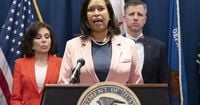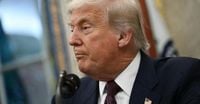As the clock struck midnight on August 9, 2025, the streets of Washington, D.C. buzzed with the usual nightlife energy—revelers spilled out of clubs, city police kept a watchful eye, and the scent of late-night snacks wafted through the air. But beneath this seemingly ordinary scene, a storm of political tension brewed, triggered by President Donald Trump’s dramatic promise: a federal law enforcement surge and the looming threat of a federal takeover of the nation’s capital.
Trump’s declaration, made Thursday and set to last for seven days with an option to extend, was nothing short of extraordinary. He insisted that D.C. was unsafe, filthy, and badly run, and vowed to transform it into "one of the country’s safest" cities. According to the Associated Press, Trump’s Thursday night announcement promised a security lockdown beginning at midnight, but as reporters toured the city’s hotspots in the early hours of Friday, they found only the familiar presence of the Metropolitan Police Department—no sign of the multi-agency federal show of force that had been forecast.
The catalyst for this high-stakes standoff was an assault the previous weekend. A staffer from the Department of Government Efficiency, identified as 19-year-old Edward Coristine, was attacked in an attempted carjacking in the Dupont Circle neighborhood. Police arrested two 15-year-old suspects, both from Maryland, and continued to search for additional participants. Coristine, who was with his significant other at the time, reportedly shielded her before being assaulted by a group of ten young people. Officers patrolling the area intervened, arresting the suspects on charges of unarmed carjacking. The incident quickly became a political flashpoint, with Trump sharing a photo of Coristine’s injuries on social media and declaring, “If D.C. doesn’t get its act together, and quickly, we will have no choice but to take Federal control of the City.”
Trump’s threats were not idle. On Saturday, August 9, he announced a White House press conference for the following Monday, promising to “essentially, stop violent crime in Washington, D.C. It has become one of the most dangerous cities anywhere in the World. It will soon be one of the safest!!!” he wrote on Truth Social. The president’s rhetoric struck a nerve, especially as he floated options ranging from repealing the city’s limited "home rule" autonomy to deploying the National Guard “maybe very quickly.”
Yet, the facts on the ground painted a more nuanced picture. Despite Trump’s claims of a city spiraling out of control, violent crime in Washington, D.C. had actually been on the decline. According to FBI statistics cited by NewAmericanJournal.net, the city’s violent crime reached a 30-year low in early 2025, with a 26 percent drop compared to the previous year. Homicides fell by 13 percent, following a 32 percent drop the year before. Carjackings, which spiked in 2023 with 957 incidents, dropped to just under 500 in 2024, and were on track to decline further in 2025, with fewer than 200 recorded by midyear. Still, juveniles continued to make up more than half of carjacking arrests, leading the D.C. Council to pass emergency legislation imposing tighter youth curfews and empowering Police Chief Pamela Smith to declare temporary curfew zones for minors.
The city’s response to youth crime has been swift. Mayor Muriel Bowser, who in April announced a special police unit dedicated to juvenile crime prevention, has taken steps to address the new wave of rowdy teens causing disturbances in public spaces. The emergency legislation allows police to break up groups of nine or more under-18s after 8 p.m. in designated areas. Yet, Bowser herself has remained silent in the face of Trump’s threats, declining to comment publicly despite mounting pressure from both Congress and the White House.
As the political drama unfolded, the federal government’s own actions sent mixed signals. The Federal Emergency Management Agency (FEMA) announced a 44 percent reduction in D.C.’s urban security fund, even as Trump called for more federal presence in the city. Other major cities, including Chicago, New York, Los Angeles, San Francisco, and Jersey City, also faced cuts, but D.C.’s was the largest, according to multiple reports.
On the ground, federal operations did ramp up. A White House official reported that more than 120 federal agents from agencies such as the Secret Service, FBI, and U.S. Marshals Service were on duty Friday night, resulting in arrests for possession of two stolen firearms, suspected fentanyl, and marijuana. The official, who spoke anonymously to the Associated Press, described this as “the first step in stopping the violent crime that has been plaguing the streets of Washington, D.C.”
Trump’s authority to deploy federal law enforcement in D.C. is clear, but a full federal takeover—including control of the Metropolitan Police Department—would require a declaration of emergency and congressional repeal of the Home Rule Act of 1973. That law, signed by President Richard Nixon, granted D.C. residents the right to elect their own local government after decades of federal control. Legal experts suggest that any attempt to revoke home rule would face immediate court challenges.
The city’s unique status—without a voting representative in Congress and with only limited self-government—makes it particularly vulnerable to federal intervention. Monica Hopkins, executive director of the ACLU of the District of Columbia, explained to the Associated Press that the Home Rule Act was specific to Washington, noting, “The district had been previously run by federally appointed commissioners and members of Congress, some of whom balked at having to deal with potholes and other details of running a city of 700,000 residents.”
Democratic leaders were quick to denounce Trump’s actions. Ken Martin, head of the Democratic National Committee, called the president’s threat “unconstitutional” and “authoritarian,” arguing at a D.C. cookout on August 9, “It’s unconstitutional what he’s doing, weaponizing the government against its people. We’re going to stand up and fight back.” Martin emphasized that the issue transcends partisan politics, saying, “The things that always connected us regardless of ideology, regardless of party. Things like respect for our Constitution. Respect for the rule of law. Respect for due process.”
Former Republican National Committee chairman Michael Steele, a native Washingtonian, also weighed in, telling cable news viewers, “I’m just kind of sick of this. You do not have the same rights as every other American. Just back the hell up, President Trump.”
Meanwhile, Trump’s administration has taken other steps to assert federal control—ordering the removal of the Black Lives Matter street mural, restoring a Confederate statue toppled in 2020, and increasing National Park Service crackdowns on homeless encampments and public marijuana use. For many Washingtonians, these actions feel like a steady erosion of the city’s autonomy.
As Monday’s White House press conference approaches, the nation’s capital remains on edge. Residents, city officials, and political leaders alike are watching closely, weighing the balance between public safety and self-government—a balance that has defined D.C.’s identity for generations.

